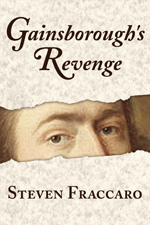Bob Guerra is an intriguing personality, someone I’ve known
for nearly ten years. He’s best known as an art director on numerous feature
films, often working for the designer
Dante Ferretti, whose work was recently
the subject of an exhibition at MOMA. What is less well known is Bob’s work as
a painter, the tone and style of which may surprise people who know him from
his film work.
The paintings I recently saw at his studio are distinctly
political, though not in the sense of proselytizing for a specific point of
view. Satirical, they are perhaps best considered as being in the tradition of
George Grosz. In some ways, the draftsmanship and color palette remind me of
Reginald Marsh. But there’s nothing dated about these works. What they manage
to do is to hold up a mirror to our society, a funhouse mirror of sorts. And
the picture isn’t pretty.
The first painting I saw isn’t particularly American, at
least not immediately so. Titled
Napoleon Crossing the Alps, it’s a parodic reworking of Jacques-Louis David’s ode to
Napoleon. Here, Napoleon sits astride a monstrous carousel horse, but he
doesn’t just sit, he is in fact one with the horse, an outgrowth of the horse’s
body.
Not a centaur, he is a travestied,
composite creature. Together, they surmount a mountain of skulls and bones. The
palette is red, white, and blue, a gray blue. To say this is about the vanity of war is to say the
obvious. Nor is it simply about Napoleon. The effect manages to be both
horrifying and darkly comical.
Hotel Haruspex
might be said to treat the same theme, albeit more mysteriously. A general sits,
wearing an elongated, cylindrical hat. To the uninitiated, this might appear to
be a dunce’s hat. In reality, it’s a representation of the hat worn by the
Etruscan soothsayer priests known as
haruspex.
These diviners read the entrails of animals. In the painting, the haruspex
holds in his hands the entrails that emanate from a set of empty Roman armor, a
mountain of skulls to the left. It is worth remembering that the Etruscans
ruled the Romans for centuries, but were then defeated and subsumed, their
civilization eliminated. Above and to the left is a film noir neon sign, the
sort of sputtering sign that signals something deadly is about to happen in a
1940s movie. The sign, not surprisingly, reads, “Hotel Haruspex.”
Forming something of a counterpoint to the first two
paintings is another pair, The Male
Politician and The Female Politician.
Neither bodes well for the electoral process. The male candidate wears a
carnival jacket, an idiotic grin besots his face as he sports an aging showgirl
on his lap, a convention hat on her head. This could be the 1940s, but the
ghostly image of the Emperor Augustus presides over them from the upper right, presaging
war, murder, mayhem. The candidate is not an Augustus figure; rather, he is
clueless, inept, skilled only at being reelected.
The Female
Politician provides a similarly jaundiced view of our electoral system. Except
that here, a woman who is not young supports an aging, ludicrous toy boy on her
lap, more a ventriloquist’s dummy than a man. He bears an eerie resemblance to
the male candidate in the matching painting.
The final work I saw was
Venus Returning to the Place of Her Birth. She indeed holds a shell,
but there the resemblance ends. This Venus is a gruff, wasted strumpet, still
proud, but no longer a beauty. Fleshy, nude, she stands in front of a
Dickensian industrial landscape, Satanic mills spewing smoke and soot, the home
town she has returned to—both she and it are ruins of themselves.
This is not an easy painting to look at. Despite the
defiance and pride, there is something sad about her, and about the bleak
industrial scene behind her, which seems both outmoded and futuristic. Perhaps
she is a product of this monstrous industry, as indeed we all are.
The five paintings I’ve described represent one strand of
the artist’s work on canvas, what I refer to as the satirical strand. A selection
of these and other works can be viewed online at the
Robert Guerra Studio.





